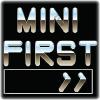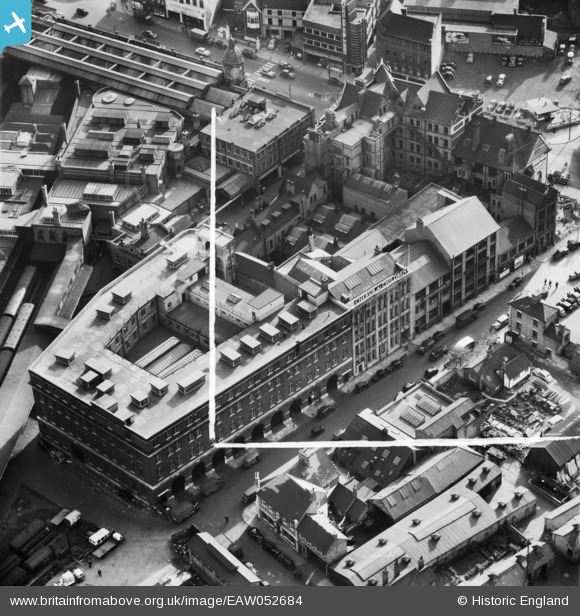 Ford Consul Mk I |

Billy Turner |
Thursday 13th of October 2016 06:40:11 PM |
 Vauxhall Velox |

Billy Turner |
Thursday 13th of October 2016 06:27:19 PM |
 Ford Consul (1950 - 1956) |

Billy Turner |
Thursday 25th of February 2016 10:54:00 PM |
 A pair of Austin A40 Devon Panel Vans (1947–56)..on delivery duties. |

Billy Turner |
Thursday 25th of February 2016 10:08:29 PM |
 Humber Hawk Mark III (1948–1954)
The Mark III Hawk was a completely new car compared to previous Hawk and was first shown at the London Motor Show in October 1948, but it still retained the earlier engine (side-valves, 1944 cc, 56 bhp at 3800 rpm) and transmission albeit with new rubber mountings. The new body was styled by the Loewy Studio and the separate headlights of the old model were gone, along with the separate front wings. The chassis was new, with coil-sprung independent front suspension replacing the previous transverse leaf spring. The body was now an integral component of the car's structure. The rear axle was also a new design with hypoid gearing. The body could be finished in a wide range of colours, both as two-tone and metallic. The metallic finishes would be offered on all the Hawks until the model's demise in late 1967/early 1968. |

Billy Turner |
Thursday 25th of February 2016 09:57:34 PM |
 Two Morris LC Post Office vans.
On the left an LC4 (1952-1953) with the smaller LC3 (1948-52) |

Billy Turner |
Thursday 25th of February 2016 09:22:44 PM |
 The World Famous Midland Coffee House |

Billy Turner |
Thursday 25th of February 2016 09:04:45 PM |
 LEAPS AHEAD!...ESSO EXTRA billboard |

Billy Turner |
Thursday 25th of February 2016 08:01:01 PM |
 Heinz Spaghetti Billboard |

Billy Turner |
Thursday 25th of February 2016 07:44:33 PM |
 A pair of Morris Commercial J-type Post Office vans (1949-1961) |

Billy Turner |
Thursday 25th of February 2016 06:26:39 PM |
 Ford Prefect E93A 4 door Saloon (1938-1949)
The Ford Prefect is a line of British cars which was produced by Ford UK between 1938 and 1961 as a more upmarket version of the Ford Popular and Ford Anglia models. It was introduced in October 1938 and remained in production until 1941; returning to the market in 1945, it was offered till 1961. The car progressed in 1953 from its original perpendicular or sit-up-and-beg style to a more modern three-box structure. Some versions were also built and sold by Ford Australia. |

Billy Turner |
Thursday 25th of February 2016 05:47:38 PM |
 Bedford CA (1952-1969)
The Bedford CA was a distinctive pug-nosed light commercial vehicle produced between 1952 and 1969 by Bedford in Luton, United Kingdom.
It was manufactured in short-wheelbase and long-wheelbase forms, each form available in either a 10–12 cwt or a 15 cwt version.
Generally it was supplied as a light delivery van with sliding doors, but it was also available as a chassis with cowl upon which specialist bodywork could be added. The Bedford Dormobile was a Campervan conversion based on the Bedford CA van.
In its day, the vehicle was ubiquitous; the Ford Transit of its time. These vehicles are now rare.
The CA was also exported to Canada and sold as the Envoy CA, as part of the Envoy brand line-up. |

Billy Turner |
Thursday 25th of February 2016 05:39:14 PM |
  Ford Anglia E04A (1939–48)
The patriotically named first Ford Anglia, launched soon after Britain declared war on Germany in early September 1939,[3] and given the internal Ford model code of E04A, was a facelifted version of the Ford 7Y, a simple vehicle aimed at the cheap end of the market, with few features. Most were painted Ford black. Styling was typically late-1930s, with an upright radiator. There were standard and deluxe models, the latter having better instrumentation and, on pre-war models, running boards. Both front and rear suspensions used transverse leaf springs, and the brakes were mechanical.
The two-door Anglia is similar to the longer, four-door, E93A Ford Prefect. A bulge at the back enabled a spare wheel to be removed from its vertical outside stowage on the back of the car and stowed flat on the boot floor, which usefully increased luggage space. Some back seat leg room was sacrificed to the luggage space, being reduced from 43¾ inches in the Ford 7Y to 38½ inches in the Anglia |

Billy Turner |
Thursday 25th of February 2016 05:19:25 PM |















![[EAW052684] Arthur Foister and Sons Ltd (Cherub Ltd) Factory on Campbell Street, Leicester, 1953. This image was marked by Aerofilms Ltd for photo editing.](http://britainfromabove.org.uk/sites/all/libraries/aerofilms-images/public/100x100/EAW/052/EAW052684.jpg)
![[EAW052685] Arthur Foister and Sons Ltd (Cherub Ltd) Factory on Campbell Street and London Road Railway Station, Leicester, 1953. This image was marked by Aerofilms Ltd for photo editing.](http://britainfromabove.org.uk/sites/all/libraries/aerofilms-images/public/100x100/EAW/052/EAW052685.jpg)
![[EAW052686] Arthur Foister and Sons Ltd (Cherub Ltd) Factory on Campbell Street and London Road Railway Station, Leicester, 1953. This image was marked by Aerofilms Ltd for photo editing.](http://britainfromabove.org.uk/sites/all/libraries/aerofilms-images/public/100x100/EAW/052/EAW052686.jpg)
![[EAW052688] Arthur Foister and Sons Ltd (Cherub Ltd) Factory on Campbell Street and London Road Railway Station, Leicester, 1953. This image was marked by Aerofilms Ltd for photo editing.](http://britainfromabove.org.uk/sites/all/libraries/aerofilms-images/public/100x100/EAW/052/EAW052688.jpg)
![[EAW052689] Arthur Foister and Sons Ltd (Cherub Ltd) Factory on Campbell Street and London Road Railway Station, Leicester, 1953. This image was marked by Aerofilms Ltd for photo editing.](http://britainfromabove.org.uk/sites/all/libraries/aerofilms-images/public/100x100/EAW/052/EAW052689.jpg)
![[EPW014913] London Road Station and environs, Leicester, 1926. This image has been produced from a print.](http://britainfromabove.org.uk/sites/all/libraries/aerofilms-images/public/100x100/EPW/014/EPW014913.jpg)
![[EAW052682] Arthur Foister and Sons Ltd (Cherub Ltd) Factory on Campbell Street and London Road Railway Station, Leicester, 1953. This image was marked by Aerofilms Ltd for photo editing.](http://britainfromabove.org.uk/sites/all/libraries/aerofilms-images/public/100x100/EAW/052/EAW052682.jpg)
![[EAW052683] Arthur Foister and Sons Ltd (Cherub Ltd) Factory on Campbell Street and London Road Railway Station, Leicester, 1953. This image was marked by Aerofilms Ltd for photo editing.](http://britainfromabove.org.uk/sites/all/libraries/aerofilms-images/public/100x100/EAW/052/EAW052683.jpg)
![[EAW052687] Arthur Foister and Sons Ltd (Cherub Ltd) Factory on Campbell Street and London Road Railway Station, Leicester, 1953. This image was marked by Aerofilms Ltd for photo editing.](http://britainfromabove.org.uk/sites/all/libraries/aerofilms-images/public/100x100/EAW/052/EAW052687.jpg)
![[EPW018434] The YMCA and environs, Leicester, 1927](http://britainfromabove.org.uk/sites/all/libraries/aerofilms-images/public/100x100/EPW/018/EPW018434.jpg)
![[EPW061212] The London Road Railway Station and environs, Leicester, 1939](http://britainfromabove.org.uk/sites/all/libraries/aerofilms-images/public/100x100/EPW/061/EPW061212.jpg)
![[EAW052678] Colton Street and Arthur Foister and Sons Ltd (Cherub Ltd) Factory on Charles Street, Leicester, 1953. This image was marked by Aerofilms Ltd for photo editing.](http://britainfromabove.org.uk/sites/all/libraries/aerofilms-images/public/100x100/EAW/052/EAW052678.jpg)
![[EAW052679] Colton Street and Arthur Foister and Sons Ltd (Cherub Ltd) Factory on Charles Street, Leicester, 1953. This image was marked by Aerofilms Ltd for photo editing.](http://britainfromabove.org.uk/sites/all/libraries/aerofilms-images/public/100x100/EAW/052/EAW052679.jpg)
![[EAW052675] Arthur Foister & Sons Ltd (Cherub Ltd) Factory on Charles Street, Leicester, 1953. This image was marked by Aerofilms Ltd for photo editing.](http://britainfromabove.org.uk/sites/all/libraries/aerofilms-images/public/100x100/EAW/052/EAW052675.jpg)
![[EAW052681] Arthur Foister and Sons Ltd (Cherub Ltd) Factory on Charles Street and St George's Church, Leicester, 1953. This image was marked by Aerofilms Ltd for photo editing.](http://britainfromabove.org.uk/sites/all/libraries/aerofilms-images/public/100x100/EAW/052/EAW052681.jpg)
![[EAW052677] Rutland Street and St George's Church, Leicester, 1953. This image was marked by Aerofilms Ltd for photo editing.](http://britainfromabove.org.uk/sites/all/libraries/aerofilms-images/public/100x100/EAW/052/EAW052677.jpg)
![[EAW052676] Arthur Foister & Sons Ltd (Cherub Ltd) Factory on Charles Street and St George's Church, Leicester, 1953. This image was marked by Aerofilms Ltd for photo editing.](http://britainfromabove.org.uk/sites/all/libraries/aerofilms-images/public/100x100/EAW/052/EAW052676.jpg)
![[EAW052674] Arthur Foister & Sons Ltd (Cherub Ltd) Factory on Charles Street, St George's Church and Rutland Street, Leicester, 1953. This image was marked by Aerofilms Ltd for photo editing.](http://britainfromabove.org.uk/sites/all/libraries/aerofilms-images/public/100x100/EAW/052/EAW052674.jpg)
![[EAW052680] Arthur Foister and Sons Ltd (Cherub Ltd) Factory on Charles Street, Leicester, 1953. This image was marked by Aerofilms Ltd for photo editing.](http://britainfromabove.org.uk/sites/all/libraries/aerofilms-images/public/100x100/EAW/052/EAW052680.jpg)












